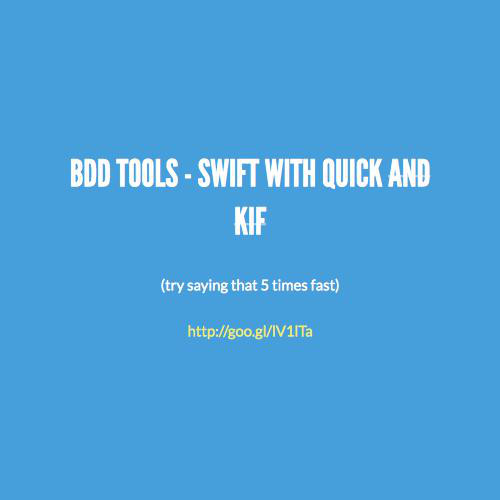SWIFTLY TESTING WITH QUICK
Who am i?
- Rubyist.
- 8 years of professional programming experience.
- I help run SwiftCast.TV, SwiftToolbox, and iSCREAMsocial.
- Wanna-be musician.
- Aspiring life coach.
- @adamjleonard
- http://www.adamjleonard.com.
Goals of this talk
- Learn what testing is and why you should test.
- Understand how to implement Test-Driven Development in to your every day work.
- Learn how to leverage Quick and Nimble to write good tests.
What is a test?

What is a UNIT test?
A unit test is a unit of code that verifies the functionality or behavior of a unit of your system (application in our case).
There are multiple types of tests.
What DOES a test Look Like?
Example: Let's say we have a function addNumbers that takes two integers a and b as input. We expect that when we provide the input 1 and 5, the output of our function would be 6.

WHAT DOES A TEST LOOK LIKE?

What is test-driven development?

What is test-driven development?
-
Write a failing test.
-
Write the minimum amount of code to make our test pass.
-
Refactor.
- Repeat.
- TDD for short
Pros of tDD
- Better code quality (less coupling and higher cohesion).
- Ability to refactor without fear of breaking things.
- Increased protection from defects such as regressions.
- Tests provide documentation for expected functionality.
- Fast feedback loop.
- Increased confidence.
CONS OF TDD
- Steep learning curve (different tools/methodologies).
- Increased setup costs.
- Slower feature development due to writing associated tests.
- Increased cost of test maintenance as projects progress.
What we will be building
We will be building a simple Bank Account.
Our Bank Account will have the following functionality
- Deposit money
- Withdrawal money
- Apply overdraft fee
What is quick and nimble?
Quick is a BDD (Behavior-driven development) testing framework for Swift and Objective-C.
Nimble is a Matcher framework for Swift.
Installing quick and nimble
Clone Quick and Nimble

git clone https://github.com/Quick/Quick.git
git clone https://github.com/Quick/Nimble.git
installing quick and nimble
Add Quick.xcodeproj and Nimble.xcodeproj to your test target
Right-click on the group containing your application's tests and select "Add Files to *Your Application Name*"
INstalling quick and nimble
Select Quick.xcodeproj from the path in which you cloned it.
Follow the same steps for Nimble.xcodeproj
Installing quick and nimble
Link Quick.framework and Nimble.framework
WRiting our first test

Watching our test fail

Getting to know xcode and testing
- From Test Navigator (CMD + 5)
- Click on the play button next to our BankAccountSpec.

- Right click on the test and choose Test *Test name*. Same for BankAccountSpec. Test "BankAccount Spec"

GETTING TO KNOW XCODE AND TESTING
- From the code
- Click the play button next to our class definition.

- CTRL + CMD + U
- Will test without building
- SHIFT + CMD + U
- Will test with building
GETTING TO KNOW XCODE AND TESTING
What happens then there is an error?
- XCode will tell us a test failed.
- In the Test Navigator we will see an X next to the failing test.
- In the code there will be an X next to the failing expectation. With the expect x, but got y.

implementing the bank account class
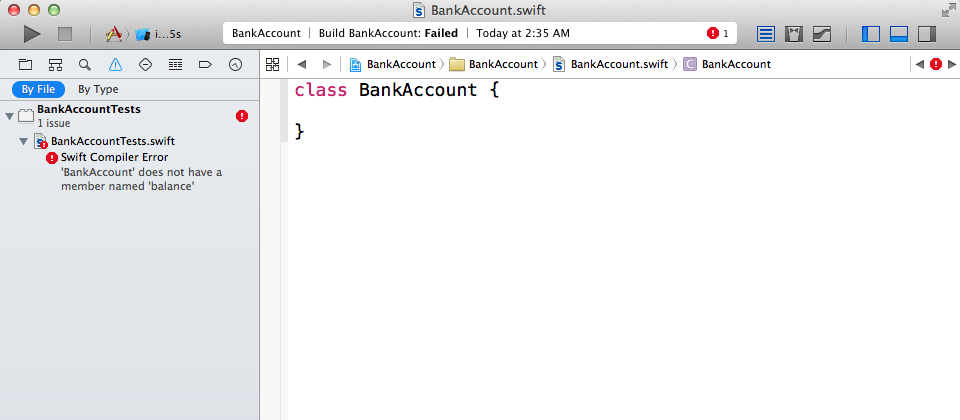
IMPLEMENTING THE BANK ACCOUNT CLASS

What we have learned so far
- What a unit test is.
- What Test-Driven Development or TDD is.
- How to install Quick and Nimble.
- How to write our first test.
- How to run and view our tests results.
- How to happy dance.
GETTING TO know nimble
- to - Expect it to match.
- toNot - Expect it to not match.
- beCloseTo(expectedValue, within: Double = 0.0001)
- beLessThan(upperLimit)
- beGreaterThan(upperLimit)
- be(Less|Greater)ThanOrEqualTo(lowerLimit)
- raiseException()
- beNil()
- beTruthy() - That it's true
- beFalsy()
GETTING TO KNOW NIMBLE
- contains(items: T...)
- Swift Collections that have Equatable elements
- NSArrays and NSSets
- Strings - Uses substring matching
- (begin|end)With(starting: T)
- Swift Collections that have Equatable elements
- NSArrays
- Strings - which uses substring matching
-
endsWith(ending: T)
- Same as above
- beEmpty()
- Works with Strings and Collections from Swift + Obj-C
GETTING TO KNOW NIMBLE
New Awesomesauce! Operator Overload!
- == instead of .to(equal(expected))
- != instead of .toNot(equal(expected))
- === instead of .to(beIdenticalTo(expected))
- !=== instead of .toNot(beIdenticalTo(expected))
- > instead of beGreaterThan
- < instead of beLessThan
- >= and <= be(Greater|Less)Than
GETTING TO KNOW NIMBLE
Other things you can do with Nimble
- Create your own matchers.
- Have Async Expectations.
- Replace to and toNot with toEventually and toEventuallyNot.
- Polls the expression inside expect until the given expectation succeeds within a second or given timeout.
WRITE MORE TESTS!

WRITE MORE TESTS!

WRITE MORE TESTS!

WRITE MORE TESTS!
IMPLementing withdrawal

IMPLEMENTING WITHDRAWAL

WHAT IS DESCRIBE?
Describe allows us to wrap a set of tests against one bit of functionality.
In our case, our method #withdrawal.
We use # to indicate an instance methods name.
We use . when indicating a class methods name.
This is the style I adopted from Ruby/RSpec best practices.
IMPLEMENTING WITHDRAWAL

IMPLEMENTING WITHDRAWAL
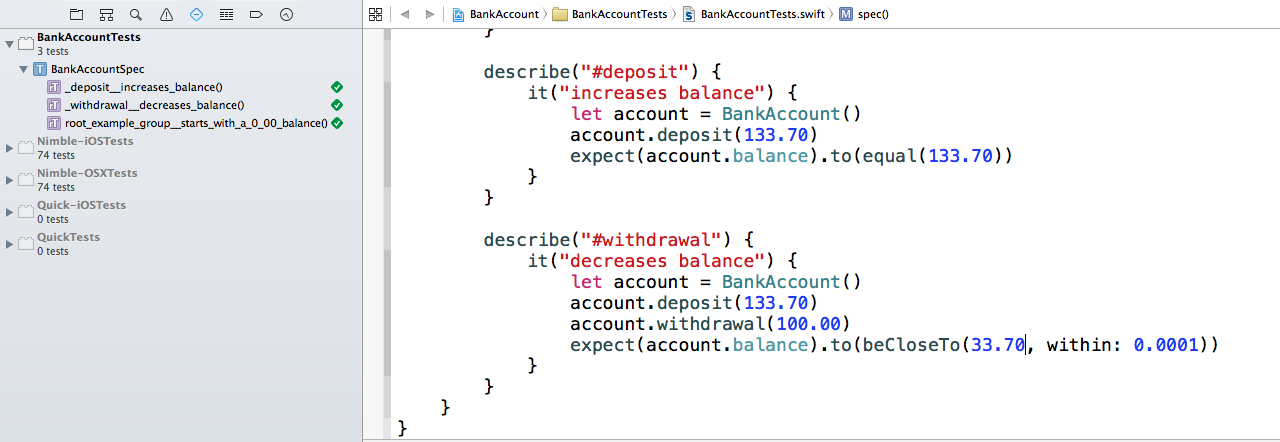
What happens if we OVERDRAW?

IMPLEMENTING THE OVERDRAFT FEE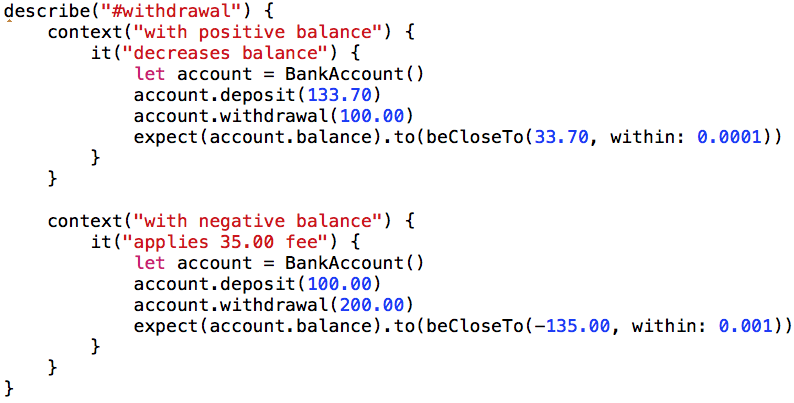
WHAT IS CONTEXT?
We use context to specify conditional behavior
with positive balance.
with negative balance.
IMPLEMENTING THE OVERDRAFT FEE
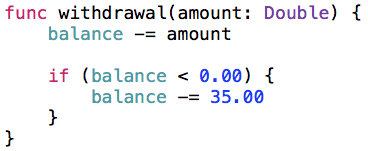
REFACTOR!
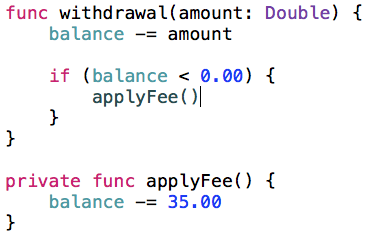
Move fee applying functionality to it's own method.
This allows us to give this bit of functionality a name.
REFACTOR!

Refactor!
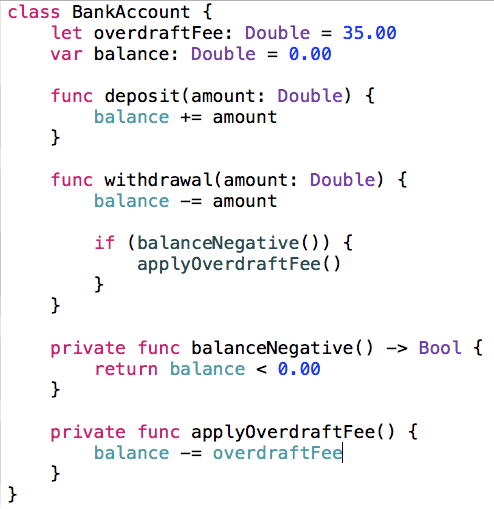
REfactoring our tests!
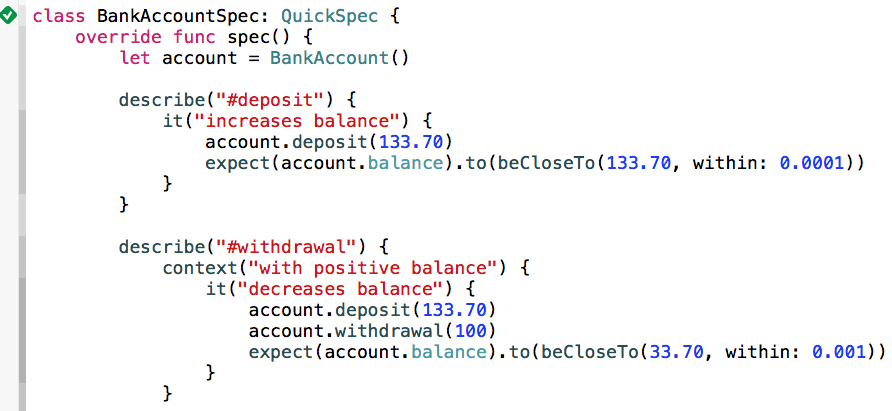
REFACTORING OUR TESTS!

We can share setup code with beforeEach
There's also afterEach (runs after each test), afterSuite, and beforeSuite.
that's it for now
Follow @adamjleonard
http://www.adamjleonard.com
Subscribe to
http://www.swifcast.tv
Add Swift libraries to
http://www.swifttoolbox.io
Get your Social Media Marketing
http://blog.iscreamsocial.io
Swiftly testing with quick
By Adam Leonard
Swiftly testing with quick
- 3,243


